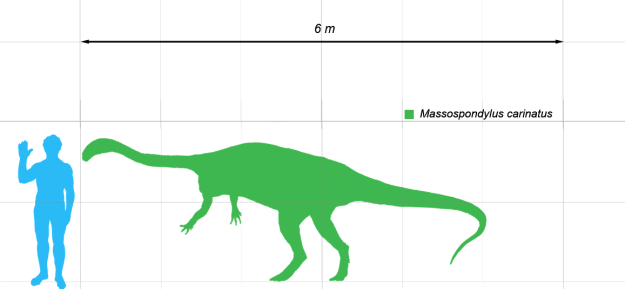
For a long time Massospondylus was depicted as a 4-legged dinosaur. But an anatomical study in 2007 showed that Massospondylus was a typical sauropodomorph dinosaur, which moved bipedally.
Its skeleton resembles that of Plateosaurus, but it has a lighter overall build. Especially the skull is proportionally smaller than Plateosaurus.
The dinosaur grew to be 4-6 meters long and had a long neck and tail. Its head was relatively small, typical of herbivorous dinosaurs. Overall, he had a slender body.
His hands were short and wide and had 5 fingers. The fourth and fifth fingers, however, were significantly shorter and thinner than the rest, giving them an asymmetrical appearance. The thumb was the longest finger of all and ended in a strong crescent-shaped claw. It was probably used for defense or for eating.
The feet also had 5 toes, the fifth of which was too short to touch the ground.
It had leaf-shaped and relatively long teeth. The teeth in the lower jaw had a constant length, those of the upper jaw however decreased in size from front to back.
Between 14 and 22 teeth were found on each side of the upper jaw, and 26 teeth on each side of the lower jaw.
No signs of abrasion could be found on the teeth, which leads to the conclusion that they frequently fell out and were replaced by new ones. The different height of the teeth also speaks for this thesis.
Many original Sauropodomorpha possessed jaws for the intake and short-term accumulation of food. In Massospondylus small openings were found on the surface of the upper and lower jaws, which contained blood vessels. This finding suggests that Massospondylus also had cheeks.
Although Massospondylus was probably a herbivore, experts speculate that it may have been omnivorous like other early sauropodomorphs.
| Profile | Name |
|---|---|
| Prehistoric Era | Lower Jurassic 201.3 to 182.7 million years ago |
| Order | Saurischia |
| Suborder | Sauropodomorpha |
| Family | Massospondylidae |
| Tribe | |
| Genus | Massospondylus |
| Species | Massospondylus carinatus (Owen, 1854) Massospondylus kaalae (Barrett, 2009) |
| Height | 1 meter |
| Length | 4 - 5 meter |
| Weight | up to over 200 kilogram |
| Territory | South Africa, Lesotho, Zimbabwe (Karoo Super Group), Arizona |
Researchers today have at their disposal well-preserved and prepared Massospondylus skeletons of both juveniles and adults.
In addition, about 20 years ago, 5 fossilized embryos were recovered in dinosaur eggs in the Golden Gate Highlands National Park in South Africa. These were freed in filigree fine work in recent time from minerals and the fossilized egg shells.
The body proportions of a freshly hatched Massospondylus were clearly different from those of an adult animal. It had a horizontal neck, a relatively heavy head and immature proportions of the limbs. Researchers therefore assume that it walked on all fours shortly after hatching.

The researchers were unable to detect any teeth on the embryos. As a result, the thesis of parental care was developed. If this assumption is really true, this would be the oldest evidence of parental care.
During further growth, the neck probably grew faster than the head and the front legs, leading to the change in body type.
It is believed that Massospondylus continued to grow steadily throughout its life.
It probably took 15 years for a Massospondylus to become fully grown and evolve from a quadruped to a biped.
The first fossils of Massospondylus were described by the paleontologist Sir Richard Owen in 1854. They were discovered a year earlier by a surveyor (Joseph Millard Orpen) on a farm site in the Drakensberg Mountains near Harrismith in South Africa.
Owen, however, did not realize that they were the fossils of a dinosaur. He thought they were the remains of a large extinct carnivorous reptile.
Image source:Contributed image Massospondylus: ©urzeittiere.net
Size: Matt Martyniuk Dinoguy2, CC BY-SA 3.0 https://creativecommons.org/licenses/by-sa/3.0, via Wikimedia Commons
Skull: CaptMondo, CC BY-SA 3.0 https://creativecommons.org/licenses/by-sa/3.0, via Wikimedia Commons
Massospondylus Baby: Nobu Tamura (http://spinops.blogspot.com), CC BY 3.0 https://creativecommons.org/licenses/by/3.0, via Wikimedia Commons
Massospondylus two-legged: Nobu Tamura (http://spinops.blogspot.com), CC BY 3.0 https://creativecommons.org/licenses/by/3.0, via Wikimedia Commons